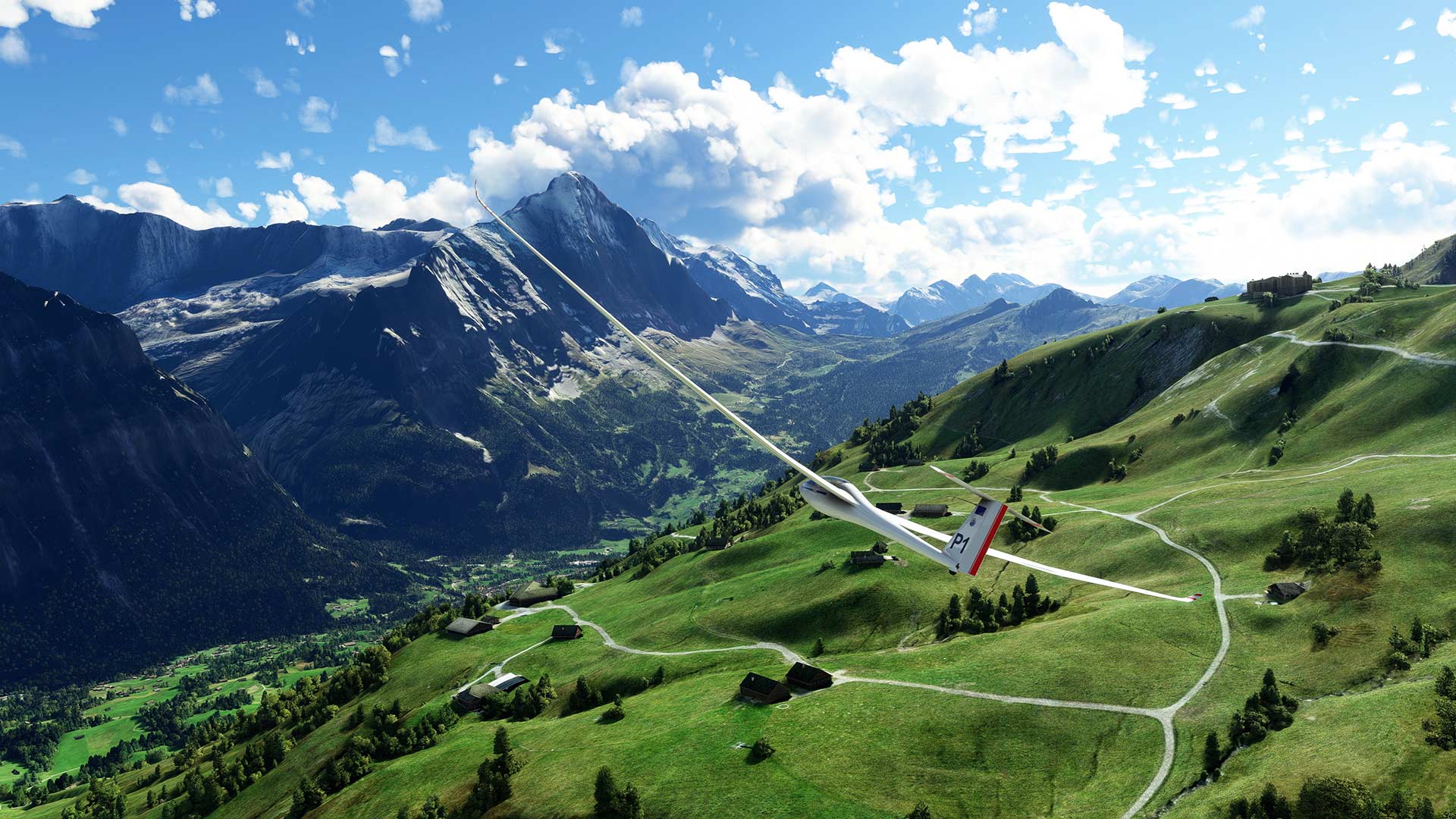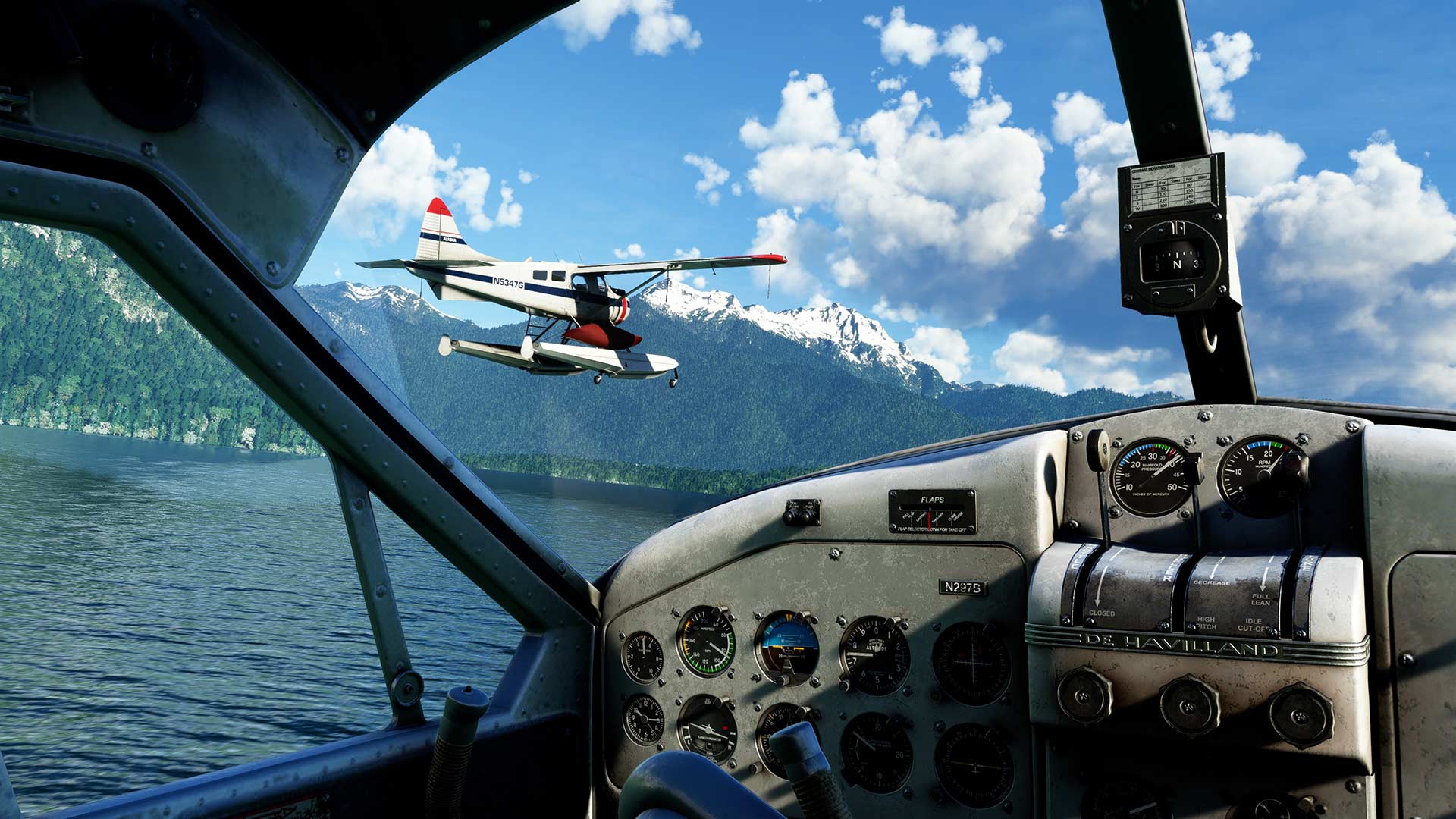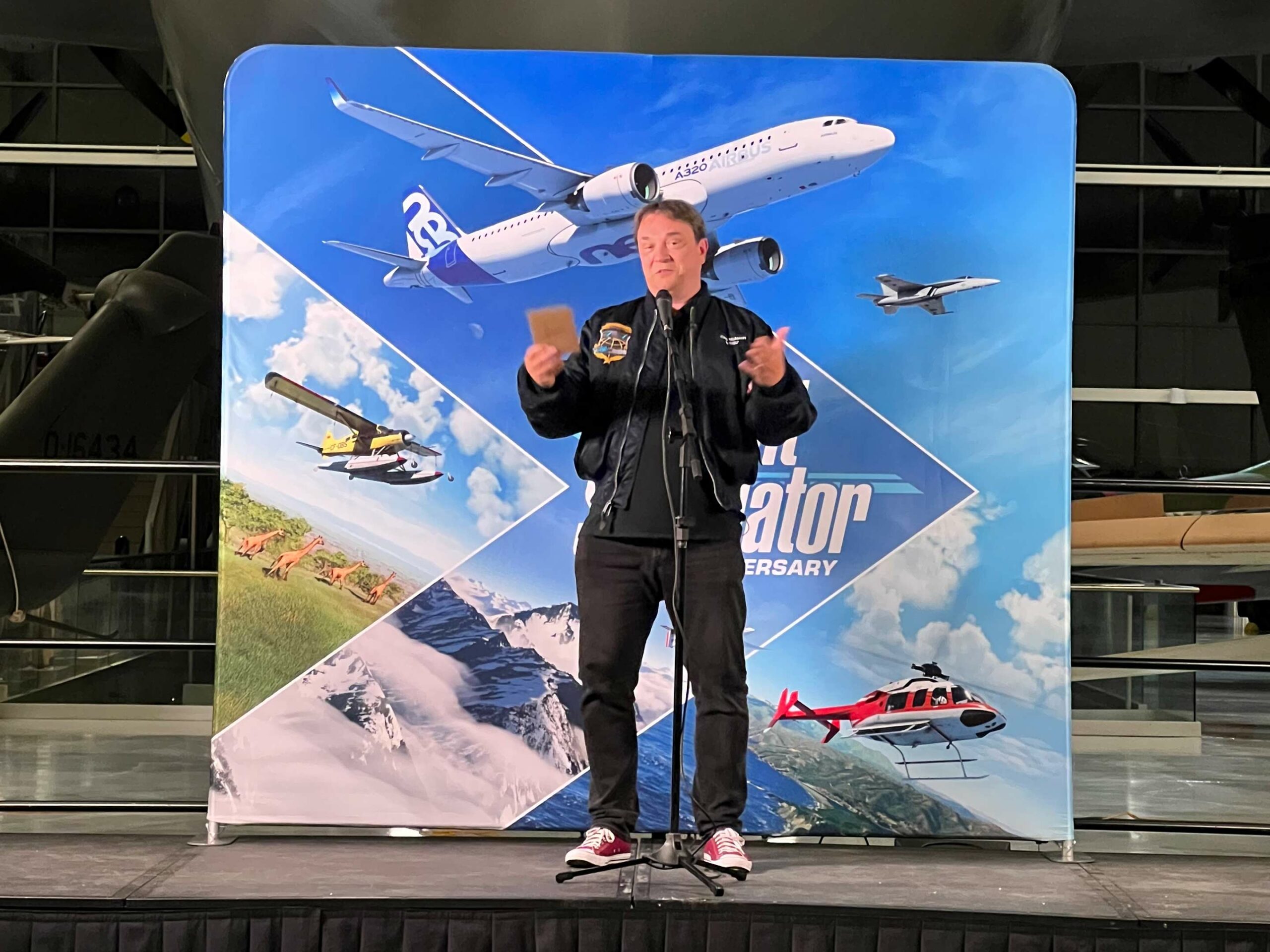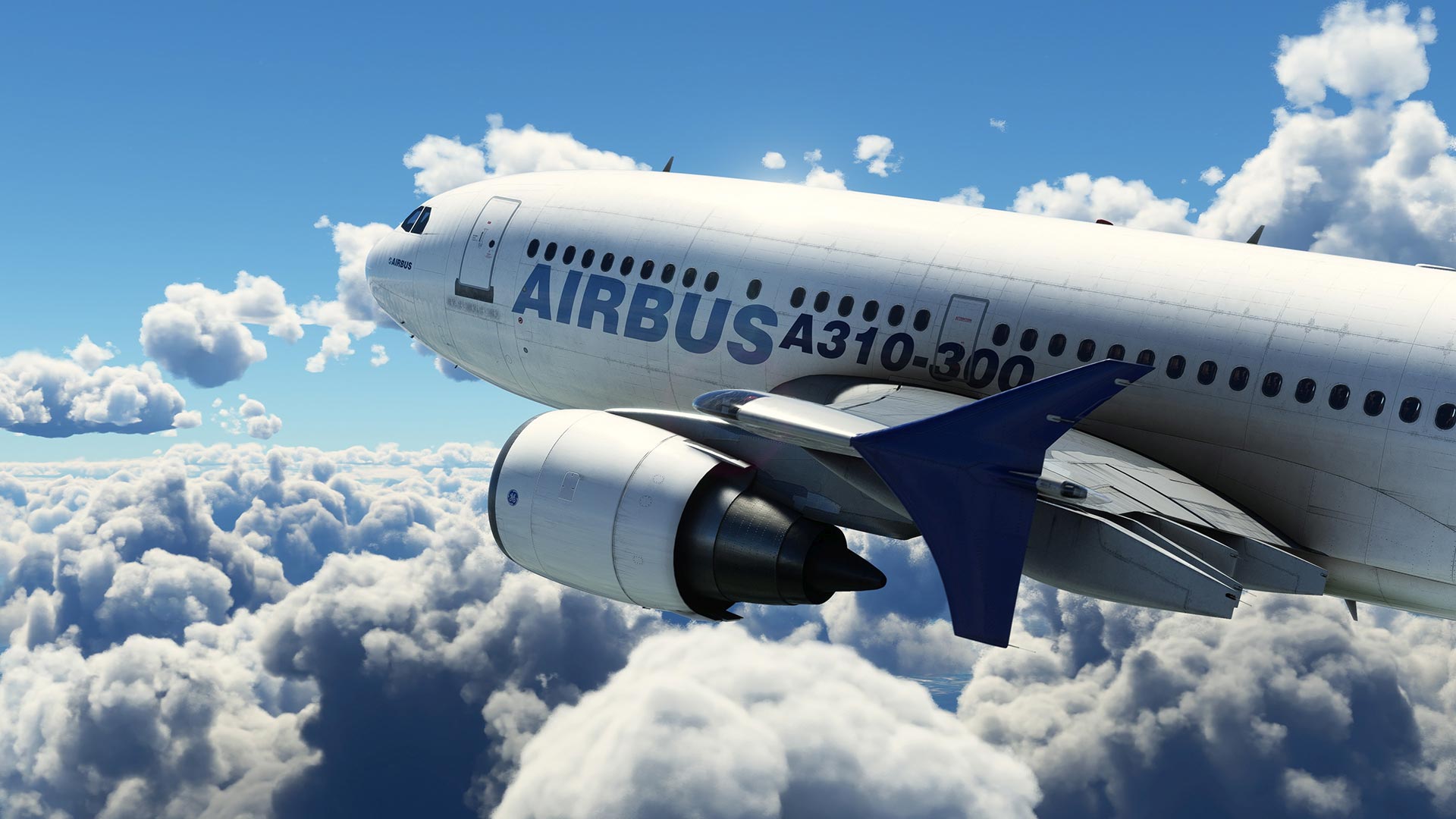As I cruised through the skies in Microsoft Flight Simulator 40th Anniversary Edition, I found myself quite relaxed.
While I’ve played Flight Sim now that it’s on Xbox, I confess that I forgot just how calming the experience can be. Indeed, the game’s unique brand of tension-free virtual tourism feels fresher than ever, especially thanks to the meaty 40th Anniversary Edition update.
“It’s as big as a sequel,” says Jorg Neumann, head of Microsoft Flight Simulator, at a preview event at the Evergreen Aviation & Space Museum in McMinnville, Oregon. He’s not lying — going through the in-game ’40th Anniversary’ section, I was impressed by the mix of new aircraft, locations and missions. Below is everything included in the update:
- 2 helicopters and 14 heliports
- 2 gliders and 15 glider airports
- 7 famous historical aircraft, including the Hughes H-4 Hercules (AKA the Spruce Goose)
- 4 classic commercial airports
- 24 classic missions from older Flight Sim games
It’s an appropriately sizeable update considering the franchise — Microsoft’s oldest product line that predates even Windows and Office — turns 40 this month. Naturally, then, the company went big for such a milestone.
A new lease on flight
Charmingly, Neumann says he views the update as a “box of chocolates,” and part of that sweetness meant listening to the fans.
The biggest requests? The inclusion of helicopters and gliders for the first time in the series since 2006’s Microsoft Flight Simulator X. Evidently, these handle completely differently from planes, so this left Microsoft Flight Simulator lead developer Asobo with a lot of work to do. Specifically, the process of implementing helicopters included at least six months of around 20 people internally playing around with the vehicles, as well as assistance from experts at fellow French company Helicoptres Guimbal.
 “I think it’s a very different flying experience — the fact that you can stop anywhere, turn around and go somewhere else,” says Sebastien Vloch, Asobo co-founder and CEO. “On a plane, you’re always on a trajectory, you’re always going forward. And so you have to sort of control your trajectory. On a helicopter, you can pretty much do whatever you want, except when you’re cruising, the helicopter is a lot trickier to fly […] It adds a new way of flying — more capabilities, you can land pretty much anywhere.”
“I think it’s a very different flying experience — the fact that you can stop anywhere, turn around and go somewhere else,” says Sebastien Vloch, Asobo co-founder and CEO. “On a plane, you’re always on a trajectory, you’re always going forward. And so you have to sort of control your trajectory. On a helicopter, you can pretty much do whatever you want, except when you’re cruising, the helicopter is a lot trickier to fly […] It adds a new way of flying — more capabilities, you can land pretty much anywhere.”
In a presentation, he showed off the helicopter in New York City alongside a nifty feature called aerodynamic visualization, which highlights all of the different ways the air is moving around the chopper. For people like me with no knowledge of aviation, it’s a simple but effective way of showing you a bit of the behind-the-scenes process while also helping you adjust positioning accordingly. For more seasoned pros, it adds even more to the experience.
“Going back to my own flying days as a helicopter pilot, I wish I had that technology to see airflow going through. Your understanding of physics, and the data visualization, is so compelling and so beautifully done,” says Tyson Weinert, president and CEO of the Evergreen Aviation & Space Museum.
Meanwhile, Vloch says the choppers can add a fun challenge.
“It reminds me when we started flying with the first airplanes — we had contests for who can land in this field. We’re doing the same with helicopters now — who can land here on this roof, who can land there. And that’s super interesting, especially if you add some wind or take out assist systems.”
While Vloch admits that there isn’t much in the way of tutorials for the helicopter because of development time constraints, I found it relatively easy to get the hang of, especially with the regular assistive settings enabled. In fact, the most fun I had in 40th Anniversary Edition was in the chopper, precisely for the reasons Vloch pointed out. In my own demo, I also flew through New York, and I found it actually peaceful. Normally, that’s not a word you’d ever use to describe New York, but it certainly applied here. In real life, New York is bustling and loud, while virtual excursions to the Big Apple, like Marvel’s Spider-Man, are also generally about getting around at high speeds. But to get to experience NYC through a realistic helicopter simulation with a chill, low-key vibe? Well, that let me see the city in a refreshingly different light. It has me eager to explore more locations with a helicopter and, hopefully, find more beauty where I perhaps wasn’t expecting to.
 By contrast, I wasn’t as in love with the gliders, though they’re not without their own charms. With their almost comically wide wing span, they certainly aren’t fit to traverse metropolitan areas, but that also just lets them complement the helicopters quite nicely. In fact, they’re also not like traditional planes, as they’re unpowered and instead rely on naturally occurring currents of air. At first, this threw me off, but I came to appreciate how it required a surprisingly engaging back-and-forth of sensitively tilting the sticks to gain speed. While not my preferred method of transportation, the glider undeniably adds even more variety to an already content-rich game.
By contrast, I wasn’t as in love with the gliders, though they’re not without their own charms. With their almost comically wide wing span, they certainly aren’t fit to traverse metropolitan areas, but that also just lets them complement the helicopters quite nicely. In fact, they’re also not like traditional planes, as they’re unpowered and instead rely on naturally occurring currents of air. At first, this threw me off, but I came to appreciate how it required a surprisingly engaging back-and-forth of sensitively tilting the sticks to gain speed. While not my preferred method of transportation, the glider undeniably adds even more variety to an already content-rich game.
Flight Sim as a means for education and connection
When I spoke to Neumann earlier this month, he mentioned how his broader ambition for Flight Sim is preservation. He envisions the series moving beyond just aviation to capture the world as it is in a given moment for future generations to look back on and study. It’s a fascinating idea, and it speaks to where this long-running series could go well beyond 40.
But for now, Flight Sim is doing a bang-up job of honouring the past, and nowhere is that more apparent than in 40th Anniversary Edition. My personal standout: the aforementioned Spruce Goose. If you’re like me and didn’t know about it before Flight Sim, the Spruce Goose was created by famed business magnate and engineer Howard Hughes to be the largest seaplane and wooden aircraft ever. That said, it was only ever flown once, given that it was intended for use during World War II but came two years too late.
I learned much of this at the Evergreen Aviation & Space Museum, in which the real Spruce Goose is housed, but Flight Sim offers a much more accessible version of this fascinating history lesson. Of course, having older planes isn’t new for Flight Sim, but it was a good reminder for casuals like me about the unique appeal of the series. The fact that everyone can fly a plane that was otherwise only ever piloted by one man is extremely cool, especially when I had the real ship right for reference.

The Spruce Goose.
What’s more, you can rest assured that, in typical Flight Sim fashion, the virtual Spruce Goose will be sufficiently authentic. According to Tyson Weinert, president and CEO of Evergreen Aviation & Space Museum, a member of the board reached out to Neumann to express interest in adding the Spruce Goose to the game. Over the course of about 18 months, Neumann and Weinert’s respective teams worked closely to make this happen, and the level of attention to detail in doing so might surprise you.
“[Neumann] and his team had to make a very specific decision to simulate the Spruce Goose on the date of its flight. And that’s the experience to simulate with the rest of the world through the 40th Anniversary Edition. And so I absolutely respect and honour that decision, because it’s very special,” says Weinert. “Which means that his team had to be very intentional about getting all their scans, and actually removing some of the components that wouldn’t have been there [like the fire suppression system]. So by using the drawings and other photos and everything, they could correlate between what was the original configuration.”
In a similar vein, 40th Anniversary Edition lets classic commercial airports be born anew. “What I really liked was [Chicago’s] Meigs Field. If you played the old flight sims, it was always the beginning airport. But it was closed in 2003. So we didn’t have it when we launched the new sim. And we’re all kind of bummed about it, because we’re like, ‘where’s Chicago? What’s happening?’” says Neumann with a laugh. “And so we went in and did Meigs Field, we did Kai Tak in Hong Kong [closed in 1998] […] And that feels great. That feels like we’re really celebrating this the sim itself, like the series of the sim — it’ll feel very true to people who play the old ones.”
That’s to say nothing of the classic aircraft that were added alongside the Spruce Goose in the update: the 1903 Wright Flyer, the 1915 Curtiss JN-4 Jenny, the 1927 Ryan NYP Spirit of St. Louis, the 1935 Douglas DC-3, the 1937 Grumman G-21 Goose and, for Canadians, the 1947 Havilland DHC-2 Beaver.

The Beaver.
For Weinert, whose career is obviously focused on preservation, such content makes Flight Simulator an especially remarkable game.
“Part of our vision is around that connection between being curious, so having that learner’s mindset, that growth mindset, and then having the courage to do something about your curiosity, and then that will connect you to experiencing more confidence in life and whatever it is you want to pursue. Before [Flight Sim], all of our global visitors could have come here and they could have been curious. They may have had the courage to look into flight in some other way, and then maybe that built some confidence. But with [Flight Sim] in place now, I believe that that cognitive cycle is going to accelerate and scale to more people,” he says.
“Because if you’re curious about any one of these aircraft, especially the Spruce Goose, and then because of the accessibility that Flight Simulator offers, all of those curious learners can now have the courage to fly it in a safe environment, in a fun environment, in a delightful environment. And then who knows where that curiosity to courage to confidence — that journey — might look like for them?”
Key to all of that, undoubtedly, is Neumann himself. I’ve spoken to him on three occasions now, and each time he’s been one of the most enthusiastic, friendly and knowledgeable figures I’ve come across in the gaming industry. While he humbly praises the many global teams that assist with Flight Simulator — “all I have to do is pick the right people who know how to do the job and leave them alone” — it’s clear that his unbridled passion helps keep it all alive. Earlier in the pandemic, The Wind Rises and other masterworks of Hayao Miyazaki compelled me, in no small part, due to their celebrations of the joys of aviation. To quote Weinert, they certainly got me curious. But Flight Sim, fuelled by Neumann’s infectious positivity and the unique interactive elements of gaming, has offered me a platform to actually take that curiosity just a bit further, and it’s one I’ve genuinely come to like. All told, witnessing the many aircraft at the Evergreen Museum, all technical marvels in their own right, and then seeing how much love and care went Neumann and co. put into recreating that certainly resonated with me.

Neumann.
For Neumann, that’s exactly what it boils down to.
“If you care about planes, this is the best time ever. Certainly, if you play a simulation game about planes, that has always been somewhat on the side, people didn’t pay that much attention. It was sort of a geeky hobby to some degree. And now it’s totally not, and people are interested. Where I get my energy from is talking to people like yourself, or getting an email from an eight-year-old telling me that they fell in love with aviation. I mean, what else do you want out of life?”
That Flight Simulator has endured for so long, Neumann notes, is also a testament to the vast, wide-reaching and ever-evolving potential of aviation.
“First off, I believe aviation manages to connect the planet. We can sit here today because aviation exists. If that didn’t exist, we wouldn’t be here — that is just a fact. Then you can say aviation is self-aware enough that they need to change. Everybody knows it’s not exactly the cleanest industry ever; it pumps a lot of stuff into the atmosphere. What do they do? They come up with a bunch of solutions. I want to be part of that solution. If I can propagate electric planes, that’s awesome, I’ll do it right away. And there’s so much innovation going on — that’s cool. So we’re looking back, we’re celebrating the history of aviation, we’re making a cool digital twin — who doesn’t like that? And you get to be on the cutting-edge of technology that literally is important to this entire civilization of ours. It literally doesn’t get any better.”
The 40th Anniversary Edition is now available as a free update to Microsoft Flight Simulator on PC and Xbox Series X/S. Flight Simulator is also included with Xbox Game Pass for console and PC, as well as Xbox Cloud Gaming via Xbox Game Pass Ultimate.
Image credit: Xbox









